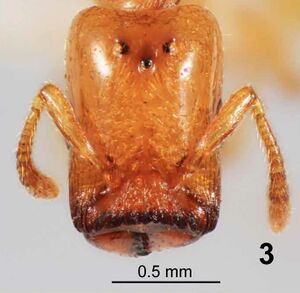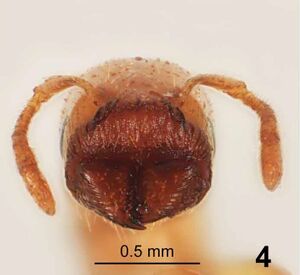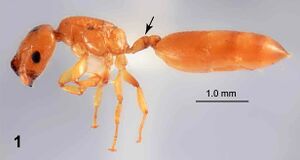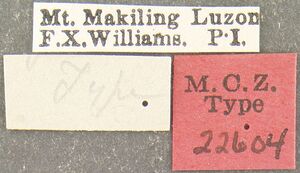Crematogaster cylindriceps
| Crematogaster cylindriceps | |
|---|---|

| |
| Scientific classification | |
| Kingdom: | Animalia |
| Phylum: | Arthropoda |
| Class: | Insecta |
| Order: | Hymenoptera |
| Family: | Formicidae |
| Subfamily: | Myrmicinae |
| Tribe: | Crematogastrini |
| Genus: | Crematogaster |
| Species: | C. cylindriceps |
| Binomial name | |
| Crematogaster cylindriceps Wheeler, W.M., 1927 | |
Crematogaster cylindriceps nests in living stems of climber plants and is thought to be unique among Crematogaster species (cf. Emery 1922; Buren 1959; Longino 2003). Most of the diagnostic characteristics seen in the queen seem to reflect the specialisation of this species under strong competition for nesting sites during evolution. This species was originally described from the Philippines by Wheeler in 1927, and thereafter has never been collected again. As we could not find any important difference between the holotype of C. cylindriceps and the Bornean queens, our sample could represent a second locality for this rare ant. However, the conspecificity of these populations could not be confirmed since the head of the type has been lost so that we could not observe the most important part of the body. We also need the worker caste collected in the Philippines from a colony series together with the queen for a more reliable identification. (Yamane et al., 2011).
| At a Glance | • Phragmotic |
Identification
Distribution
Distribution based on Regional Taxon Lists
Indo-Australian Region: Philippines (type locality).
Oriental Region: Cambodia.
Distribution based on AntMaps
Distribution based on AntWeb specimens
Check data from AntWeb
Countries Occupied
| Number of countries occupied by this species based on AntWiki Regional Taxon Lists. In general, fewer countries occupied indicates a narrower range, while more countries indicates a more widespread species. |

|
Estimated Abundance
| Relative abundance based on number of AntMaps records per species (this species within the purple bar). Fewer records (to the left) indicates a less abundant/encountered species while more records (to the right) indicates more abundant/encountered species. |

|
Biology
The host plant in the secondary forest was a climber, Spatholobus sp., in the family Leguminosae (Fabaceae), which is a main host plant of a plant-ant, Cladomyrma hobbyi (Agosti et al. 1999). Dealated queens, workers and males of Crematogaster sp. cf. cylindriceps were collected from a living stem between 0.5 m and 1 m above the ground. The colony could be considered polygynous because several dealated queens were found from adjacent internodes cut from the main body of the stem, and because at least three dealated queens were found together in a single internode. All other ant colonies found in more slender stems of the same plant belonged to Cladomyrma hobbyi.
In a nearby primary forest (8 ha plot in Lambir Hills National Park) additional dealated queens and workers of Crematogaster sp. cf. cylindriceps were discovered at around 24 m above the ground in a stem of a climber, Uncaria longiflora (Rubiaceae). A colony of Tetraponera inversinodis (the type series of T. inversinodis was collected from mangrove twigs; see Ward 2001) was also found from the same plant, and prior to these collections a colony of Tetraponera pilosa was found inhabiting the same plant (Ward 2001, mentioned that this species nests in vines as well as dead twigs of trees). The outer and inner diameters of the internodes from which Crematogaster sp. cf. cylindriceps ants were collected were 5 and 3 mm, and 8 and 3 mm, respectively. Scale insects were not observed in the internodes. These observations suggest that in both secondary and primary forests different internodes (segments) of the host plants can be occupied by different ant species and that intra- and interspecific competition may frequently occur for nesting sites.
The most well-known case of phragmosis is commonly seen in the Colobopsis (Wilson 1972). In this group both the queen and soldier castes have a characteristically truncated head. This morphological specialisation is considered to have evolved as a defense against heterospecific and/or conspecific competitors under situations where nesting sites (twigs, branches and stems) are limited resources. A similar scenario can be pictured for Colobocrema, although no direct observation on the queen behaviour is available (see also Wheeler 1927).
Castes
- Queen
      
| |
| . | |
- Male

| |
| . | |
Nomenclature
The following information is derived from Barry Bolton's Online Catalogue of the Ants of the World.
- cylindriceps. Crematogaster (Colobocrema) cylindriceps Wheeler, W.M. 1927f: 31, fig. 39 (q.) PHILIPPINES (no island nominated).
- Type-material: holotype queen.
- Type-locality: Philippines: (no further data).
- Type-depository: MCZC.
- Yamane, et al. 2011: 64 (putative w.q.m.).
- Status as species: Chapman & Capco, 1951: 94; Baltazar, 1966: 250; Bolton, 1995b: 151; Yamane, et al. 2011: 64.
- Distribution: Philippines.
Description
- Description of queen
(Figs. 1–4). Five to seven specimens were measured. TL 4.5–5.5 mm; HW 0.70–0.75 mm; HL 0.98–1.08 mm; SL 0.48–0.50 mm; EL 0.23–0.25 mm; PW 0.60–0.63; WL 1.37–1.47; PTW 0.25–0.28; PPW 0.29–0.34. CI: 67–71; SC 64–69.
Head in full-face view elongate-rectangular, with the sides almost parallel and posterior margin weakly emarginated medially, and anteriorly strongly truncate; posterolateral corner of head round (Figs. 3, 4). Frontal lobe small; condylar bulb of antenna partly exposed; frontal carina rudimentary. Clypeus transversely divided by a right angle into two parts: the posterior (basal) part with a flat central disc and depressed lateral slopes, and anterior (vertical) part that is widely and shallowly excavated; the former clearly demarcated from frons; the latter weakly con- vex at apex; the border of anterior and posterior parts arched and strongly serrate. Mandible with anterior and lateral faces that are roughly triangular and of same size; the two faces meet almost at a right angle; masticatory margin of mandible with three teeth, of which the apical tooth largest, and the basal half of masticatory margin edentate; anterior faces of mandibles and anterior part of clypeus form a round flat area when the mandibles are closed. Eye oval, situated slightly anteriad on the side of head, not breaking the lateral margin of head in full-face view, almost as long as apical segment of antenna, with 13–15 ommatidia along longitudinal axis. Ocelli small, forming a low triangle; in full-face view distance between posterior ocelli slightly shorter than the distance between posterior ocellus and lateral margin of head, and as long as that between posterior ocellus and posterior margin of head. Antenna 11-segmented; scape short, only reaching the level of anterior ocellus; antennal club indistinctly 3-segmented.
Mesosoma elongate, in dorsal view distinctly more than 2 times as long as broad, anteriorly narrowed. Pronotum invisible from above except for anterior portion. Mesonotum only weakly separated from pronotum; paraptera of mesonotum strongly narrowed medially; suture separating paraptera and scutellum stronger; scutellum produced anteriorly and strongly narrowed posteriorly, with the sides carinate. Metanotum narrow, distinctly defined both anteriorly and posteriorly. Propodeum slightly narrower than mesonotum, with a short dorsal face that merges into steep posterior face; spines absent. In profile dorsal outline of mesonotum flat; pro-mesonotal separation distinct; mesopleuron clearly divided into anepisternum and katepisternum. Propodeal spiracle oval, relatively large, situated high up on lateral face of propodeum along metanotum border. Petiole with a short but distinct pedicel, the portion of node flattened until its posterior margin so that no posterior slope present, in dorsal view broader than long (but rarely as broad as long); anterolateral corner rounded; subpetioler process very low, with an anterior angle; postpetiole broader than petiole, broader than long, and with weakly convex dorsum that is not divided by longitudinal furrow into two parts; helcium large, usually partly exposed (Fig. 1, arrow). Gaster long, almost 2 times as long as broad. Legs short; fore and hind coxae larger than mid-coxa; femora of all legs short and broadened; tibiae short.
Head mostly smooth (sculpture if any very superficial) and shiny, with strong longitudinal rugae in anterior 1/4 of head capsule; venter of head with fine longitudinal striation. Central disc of basal part of clypeus irregularly striate with interspaces microsculptured; anterior part of clypeus irregularly and superficially sculptured. Anterior face of mandible with sculupture; sides of mandible with several strong carinae. Mesosoma and gaster extensively smooth to superficially sculptured; sides of petiole distinctly punctate.
Dorsa of head, mesosoma and gaster with sparse short standing hairs in addition to much shorter appressed pilosity. Venter of head with denser standing hairs and denser appressed pilosity. Antennal scape, outer faces of all legs without standing hairs; appressed hairs longer and denser on scape than on legs. Whole body yellow to yellowish brown, with head and gaster slightly darker; clypeus and mandible reddish brown; border of basal and apical parts of clypeus dark brown.
- Description of worker
(Figs. 5–8). Nine to ten specimens were measured. TL 1.75–2.00; HW 0.52–0.55; HL 0.57–0.60; SL 0.42–0.45; EL 0.13–0.14; PW 0.30–0.34; WL 0.64–0.68; PSL 0.06–0.07; PTW 0.19–0.20; PPW 0.18–0.20. CI: 88–92; SI 70–75; PSI 09–11.
Apparently monomorphic. Head in full-face view slightly longer than broad, slightly narrowed anteriorly, more strongly narrowed posteriorly, with posterior margin nearly straight (Fig. 7). Clypeus distinctly demarcated from frons, with a narrow apical rim, in profile weakly convex. Eye slightly breaking the lateral margin of head in full- face view. Mandible with anterior and basal margins parallel, with 4 teeth on masticatory margin. Antennal scape not reaching posterolateral corner of head; segment 2 as long as each of subsequent 3 segments; antennal club 2- segmented, longer than segments 3–9 combined.
Promesonotum laterally margined (Fig. 6), in profile with dorsal outline weakly and evenly convex; metanotal groove deep. Propodeum with dorsal and posterior faces continuous, without any transverse carina separating them; dorsal face with lateral carinae that reach propodeal spines, which are relatively short (PSI 09–11) and bluntly pointed apically. Petiole as long as broad, laterally margined, with flat dorsal face; its anterolateral corner bluntly angulate (Fig. 8, arrow); subpetiolar process absent; postpetiole broader than long, with a distinct median furrow dividing the dorsal face into two. Gaster longer than broad, with anterior margin straight; tergite 1 slightly longer than broad. Entire body smooth to superficially sculptured. Head capsule entirely smooth; clypeus with a pair of longitudinal carinae starting from antennal base to clypeal margin, and some indistinct shorter carinae. Mandible longitudi- nally striate. Dorsa of promesonotum and propodeum with longitudinal fine carinae; side of pronotum, meso- and metapleura partly, and posterior slope of propodeum smooth and shiny. Petiole and postpetiole dorsally smooth, laterally sculptured. Gaster and legs almost entirely smooth.
Dorsum of body with sparse standing hairs as well as very sparse appressed pilosity; venter of head with denser but slanting hairs. Antennal scape with dense suberect hairs; hairs on tibiae of all legs appressed and shorter than those on the scape. Whole body yellow; posterior half of head and gaster often darker.
- Description of male
(Figs. 9, 10). Two specimens were measured. TL 1.25–1.50; HW 0.38; HL 0.35; SL 0.08–0.09; EL 0.17–0.18. Head broader than long. Posterior ocelli very widely separated from each other, distance between them 0.19 mm, this distance only slightly shorter than that between antennal bases (Fig. 10). Eye very large, almost touching antennal base (Fig. 9), very slightly breaking the lateral margin of head in full-face view, with 13–14 ommatidia along longitudinal axis. Mandible much reduced. Antennal scape short, only slightly longer than broad; flagellar segments bead-like. Mesosoma fragile; segmentation not clearly visible. Both petiole and postpetiole short, broarder than long, somewhat globular, without constriction between them (petiole and postpetiole almost continuous); postpetiole without median furrow.
Body sculpture weak throughout. Standing hairs sparse on the dorsum of body; gastral sternites with more hairs. Antennal flagellum with very dense and thick standing hairs (Fig. 10). Head and gaster brown to dark brown; other parts white to pale yellow (but the 3 specimens examined were possibly teneral).
References
- Baltazar, C.R. 1966. A catalogue of Philippine Hymenoptera (with a bibliography, 1758-1963). Pacific Insects Monographs 8: 1-488. (page 250, listed)
- Wheeler, W. M. 1927f. The physiognomy of insects. Q. Rev. Biol. 2: 1-36 (page 31, fig. 39 queen described)
- Yamane, S.; Tanaka, M.; Itioka, T. 2011. Rediscovery of Crematogaster subgenus Colobocrema (Hymenoptera, Formicidae) in Southeast Asia. Zootaxa 2999:63-68.
References based on Global Ant Biodiversity Informatics
- General D. M., and G. D. Alpert. 2012. A synoptic review of the ant genera (Hymenoptera, Formicidae) of the Philippines. Zookeys 200: 1-111.
- Hosoishi S. and K. Ogata. 2009. A check list of the ant genus Crematogaster in Asia (Hymenoptera: Formicidae). Bull. Inst. Trop. Agr. Kyushu Univ. 32: 43-83.

